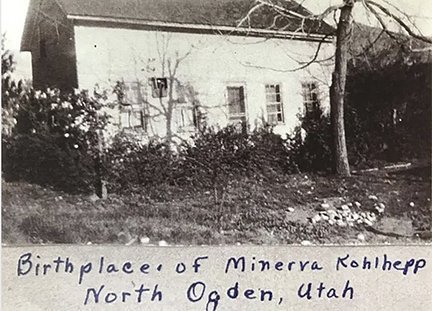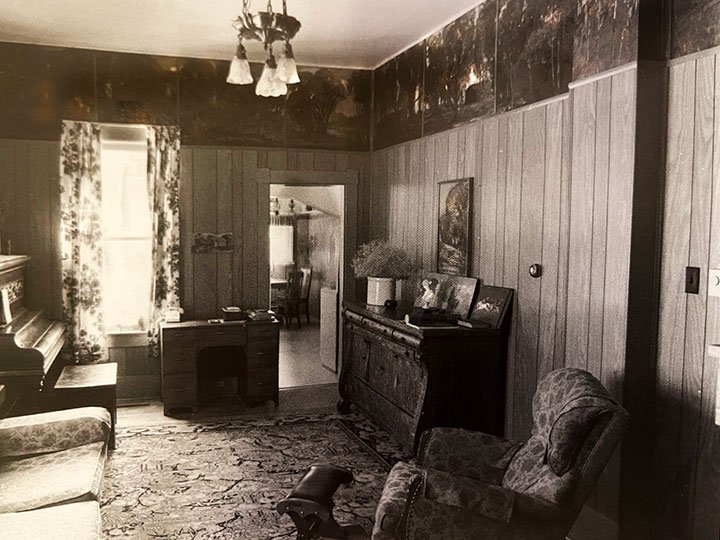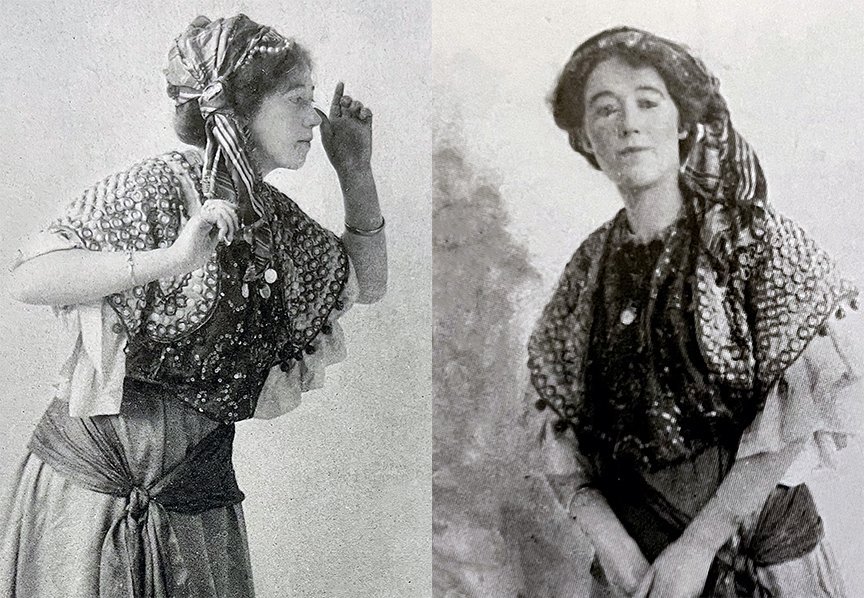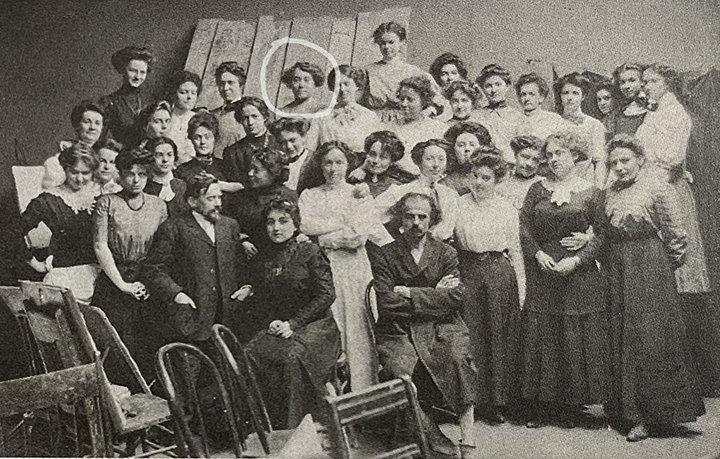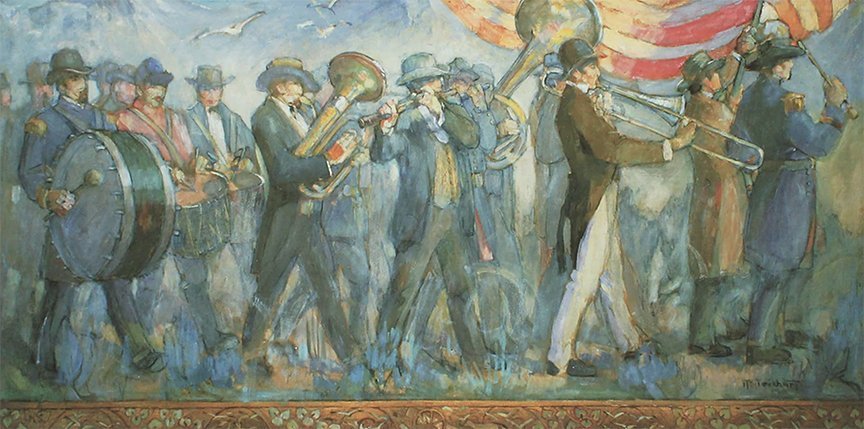Minerva Teichert born Minerva Bernetta Kohlhepp Teichert was born on August 28, 1888. She became a beloved American artist made famous by her striking paintings of Mormon history and the western frontier. Her artwork of Latter-Day Saint pioneers, scenes from the Book of Mormon, and depictions of American Indians are highly acclaimed and revered the world over.
From a in a small adobe home in Ogden, Utah the second of ten children. Minerva Teichert came from strong, independent Latter-day Saint women. Her grandmother, Minerva Wade Hickman left her husband “Wild Bill Hickman” who was a body guard for Church founder Joseph Smith and his successor Brigham Young and moved her little family of five children into a home in North Ogden. Needing more space for her family, Minerva Hickman hand made her own adobe bricks and enlarged the home that she remained in for 52 years. Minerva Hickman passed away in 1918, before she could fully appreciate the massive impact her namesake would have on the world.
The youngest of Bill and Minerva Hickman’s children was Mary Ella Hickman. She eventually married Fredrick Kohlhepp in 1886. Mary and Fred had eight children. The first two, one of which was Minerva Teichert was born in their grandmother’s old adobe brick home. Minerva Kohlhepp was named after her grandmother.
The young Kohlhepp family moved to Idaho, but the hot windy summers proved too much for young Minerva’s eyes, and she soon developed cataracts. She was forced to leave her family in Idaho and move back to North Ogden to live with her grandmother. Minerva Teichert was given a set of watercolor paints at 4 years old and claimed her whole life that those watercolors were the beginning of her love of art. Minerva attended school at the yet famous Red Brick School in North Ogden where she graduated from the eighth grade. She made her way back to Idaho eventually to be reunited with her family. At age 14 she traveled to San Francisco as a nanny for an Idaho family. While there, she visited an art museum for the first time in her life. Feeling inspired, she decided to take art classes at the Mark Hopkins Art Institute. Art classes were held in his mansion on the top of Nob Hill. It eventually became the home of the School and the San Francisco Art Association. Two very early Minerva Teichert paintings still hang in this building. Upon her return to Idaho from San Francisco Minerva graduated from High School and Immediately began teaching school to raise money for more art classes.
Birthplace of Minerva Teichert - North Ogden, Utah
Minerva Teichert Biography
Minerva Teichert Pocatello, Idaho High school graduation photo - with her lifelong friend Eva Kasiska who is seated right in front of Minerva Teichert
Minerva Teichert’s grandparents Bill & Minerva Hickman. Teichert’s mother Mary Ella was not yet born when this photo was taken.
Minerva Teichert and her sister Eda Teichert pose for a photo
Minerva Teichert performed in many plays and entreatment groups and even as a trick roper in western dances to support herself in art school.
Minerva Teichert - High School graduation photo - there were only 4 people to graduate from Pocatello, ID High School
At 19 Minerva Teichert traveled off to the booming metropolis of Chicago where she attended the Chicago Art Institute and trained under John Vanderpoel, a master at the school of painting. He often criticized Minevra’s work, in what seemed an unmercifully relentless way, while not doing the same to the other students. One day Minerva became so frustrated she confronted Vanderpoel about it. He replied as to why she, and not the other students were the focus of his critical eye - “Miss Idaho” as he often called her, “can it be possible that you don’t understand? They’re not worth it; they will drop out, but you - ah- there is no limit.”
After nearly 5 years in Chicago, at age 24 Minerva finished her art courses and returned home to Idaho. She earned money by sketching cadavers for medical schools, illustrating children’s books, and selling sketches of animals. By age 26 she had started classes at the Art Students League in New York. Her instructor, the world famous Robert Henri, considered her one of the three best students at the school and gave her a full scholarship. He encouraged Minerva to paint what he called “the Mormon experience.” “You can fill history with Mormon art and paintings” he added. She attended for three years and was then offered a scholarship to study in London, but instead returned home to Idaho to get married.
When she was 29 years old, Minerva Kohlhepp married Herman Teichert on Spetmeber 15, 1917. However, only one year after their wedding, World War 1 broke out and Herman left for battle. Although Minerva traveled with Herman throughout his boot camp training and state-side transfers, she was eventually forced to bid farewell and stayed home with their new born baby son. During the early years of their marriage, everything was in short supply because of the war, so Minerva Teichert painted art on scraps of wood and paper because there simply wasn’t enough money to buy art supplies. Fortunately, Herman returned home after the war and the couple went on to have four more children. Minerva and Herman spent most of their lives on a ranch in Cokeville, Wyoming.
Minerva Teichert paintings lined the upper walls of here living room in Cokeville, Wyoming. This photo shows the art she painted depicting the trees and nearby Snake River around which Minerva Teichert, not only grew up, but painted most of her life. These Minerva Teichert paintings are still there.
Minerva Teichert riding her horse in Cokeville, Wyoming
Minerva Teichert art classes with Robert Henri at the Art Students League in New York City in 1916 - Minerva Teichert is on third row up from the bottom and fourth student from the right.
Minerva Teichert painted and studied art along side world famous Edward Hopper in NYC at the Art Students League. She was encouraged to paint the scenes of “Mormon art history” by fellow artists.
The wild Idaho landscape was the inspiration for many Minerva Teichert paintings. Her art ranged from western American life to themes of her deeply held religious convictions. Minerva often selected subjects that emphasized the role of strong women, and these women feature prominently in many of her paintings. She was an independent, confident woman and was an outspoken on political and social matters. As her grandniece observed, “Aunt Minerva was feisty, spunky, and was a hundred years before her time, especially about women’s liberation and the roles women saw themselves in and what women were capable of doing.” Her legacy of portraying women side-by-side with men in strong heroic Mormon pioneer scenes has helped in documenting the remarkable role many women played, not only in the early migrating days of the church, but in the settlement of the Western United States.
Minerva Teichert dressed in a costume for a party at the Art Institute of Chicago in 1909 - she studied there for almost four years.
Minerva Teichert Art won first prize in the 1947 Utah Art Exposition.
With her dedication to the Mormon church, Teichart was commissioned multiple times for paintings of faith. In 1946 she was commissioned by the church to paint the “World Room” murals in the Manti, Utah Temple. She was the first woman ever asked to paint a mural for a Latter-day Saint temple. The painting was expected to take a year, but Teichart completed it in 23 days. This is even more impressive because at the time of this project, Teichert was a 59 year old grandmother. Near the completion of the mural, Teichart fell from the scaffolding and injured her arm. She left her work for a few hours and went to see a doctor. She returned and immediately started painting again, simply unwilling to stop.
Among Minerva Teichert’s most well known paintings is one titled Miracle of the Gulls. Miracle of the Gulls came about when Teichert’s neighbor confided in her that she was heartbroken, but could not afford to send her daughter to BYU. Techert was kind enough to paint Miracle of the Gulls and give the money she made from it to her neighbor’s young daughter for her college tuition. Later, when the girl got married, Techiert gave her another painting as a wedding gift. This painting, Queen Esther, ended up being one of Teichert’s most famous and beloved works. Teichert repainted Queen Ester with slight differences (such as three figures in the background as opposed to two in the original) and donated it to Brigham Young University, where it still resides to this day.
Queen Ester was also one of three paintings Teichart made in response to the Nazis in Germany. Her son served a mission for the Church of Jesus Christ of Latter-day Saints in Germany in 1938. With antisemitism at terrible levels in the years before World War II began, Teichart’s son wrote letters to his mother expressing his horror regarding the treatment of the Jewish people. Sympathetic to their plight, Teichart painted Queen Esther as a figure of courage and bravery that protected her Jewish people.
While a student at Art Student League of New York City, Minerva Teichert would visit the Metropolitan Museum Art in New York City as part of her education. This is her Copyist Ticket to the museum. A copyist is someone who practices art by mimicking or copying the styles of other artists. Minerva Teichert paintings.
Teichert’s striking paintings often reflect her Mormon upbringing and tell stories from her faith. She painted 42 wall-sized murals based on stories from the Book of Mormon. Her desire to paint dozens of scenes from the Mormon scriptures came as an extension of her feeling that she was being “called” to serve her people and her religion with her art.
A distinctive feature of Teichert’s style is her minimal use of detail. Teichert believed that a painting “should be rich in story and backed by a great faith,” often leaving the details of her paintings to the imagination of the beholder. Often, the background is suggested, rather than drawn. This contributes to the style we see in Teichart’s work, often with unfinished edges but wonderfully embellished with colors and patterns. She knew she was finished with a painting when the story had been presented in a way with which she was satisfied; she would say “I’m not going to do anything more with that. That tells the story.” For her, the attitude and position of the figures were far more important to the story than detail. Admirers of Teichert’s painting style say they are drawn to her striking use of color and highlighting. Essential to her narrative was color, which spelled out the story that she wanted to tell. She would say, “the values of color are the only thing that makes things go round, and unless you do that you haven’t accomplished anything.” Techart’s rich color work helps reflect the stories she tells in her art, with a particular focus on red for contrast.
Her husband, Herman, was always a great supporter of her career and her independence. He patiently waited five years to get married while Minerva finished art school. She told a friend, “Herman has always given me free rein to do what I please, so I try to please him, which I could not do if he tried to ‘manage’ me.” Herman was not a member of the church when the couple married, but converted and was baptized in 1933. The couple was sealed the following year in the Logan Utah Temple.
Minerva Teichert studying art at the Art Institute of Chicago for four years - starting in 1909
This lovely collage shows Minerva Teichert at three different stages of her remarkable life.
Minerva Teichert painted murals - dozens of murals throughout many rooms of the Temples of the Church of Jesus Christ of Latter-days Saints. This beautiful mural is found in the Manti, Temple in Utah.
The earliest known photo of Minerva Teichert painting Rescue of the Lost Lamb in a Church setting - photo taken Circa 1944 Bonneville Stake Center . The Rescue of the Lost Lamb painting itself was first shown in a public forum when it was loaned to Z.C.M.I. (Zions Cooperative Mercantile Institution) for several months and placed in the Tiffin Room in a small exhibit on February 28, 1939. Minerva’s daughter records this painting among other works that were on display there. The Tiffin room was a common place where Minerva Teichert would loan her art for various events & exhibits. The first publication of the art was in 1940 in “The Utah” magazine. Since there was no notice of copyright attached to both the publishing of this piece and also when she loaned her art to ZCMI without copyright notice being attached Lost Lamb, like much of her works art fell into the public domain. Some descendants of Minerva have tried to rectify the situation. However, once a piece is in the public domain, it’s all but impossible to then copyright it.
Minerva Teichert painting of the Beesley Band. This band played at many events and parades in the early days of Salt Lake City
The true power of Minerva’s strong faith is revealed in the creative conceptualization of more than forty scenes from the Book of Mormon. Her imaginative paintings offer a visual alternative to the more masculine imagery that has previously been used to show these narratives. She gave a unique and beautiful vision through Book of Mormon art. The scriptures were very important to Minerva. She studied them regularly and could quote them for almost any situation. Each of the Minerva Teichert paintings in the series was supported by scriptural references, which she was careful to list in her notes, together with a description of the sBook of Mormon scene in her own words.
As was very common, the base on Minerva’s canvases was made from a mix of lead paint and linseed oil, which, over time caused her to develop severe lead poisoning. In addition to nausea and abdominal pain she developed optic neuritis which led to a deterioration of her eyesight. She loved painting and continued despite the pain, but later in her life there was an ever-present issue whether her eyesight and health were up to the task. When asked, she simply told her friends and family, “Pray for me. I need it. I want health, eyesight, and inspiration.” Minerva painted into her 70’s when a hip fracture ended her amazing career.
Minerva Teichert in the far left speaking with a group of women in Pocatello, Idaho
Minerva Teichert with her husband and children
The original painting on canvas by Minerva Teichert Rescue of the Lost Lamb hangs in the Conference Center of the Church of Jesus Christ of Latter-Day Saints in Salt Lake City, UT.
Minerva Teichert painting of Native Americans on horseback titled Mounted Hunt - Featured at Minerva Teichert Art Gallery
Update on the Copyright of Minerva Teichert’s Art
The Church of Jesus Christ of Latter-day Saints is perhaps the largest single owner of all Minerva Teichert’s art. They certainly own the most prominent and well-known works of art she’s ever created including - Rescue of the Lost Lamb & Christ in His Red Robe. . In July of 2023 the Church opened a year-long exhibit of Minerva Teichert’s art in Salt Lake City. Before opening it to the public, members of the Teichert family were invited to a private pre-opening of the entire exhibit. Hundreds of Minerva Teichert’s descendants came to see the collection. The family expressed overwhelming feelings of love and appreciation for the marvelous presentation of Minerva’s work. “It was a remarkable privilege to have members of the Teichert family visit the museum and enjoy the beautiful works of Minerva Teichert ” said museum director Riley M. Lorimer.
However, Tim Teichert, a grandson of the late Latter-day Saint artist Minerva Teichert, claiming to represent the estate of Minerva Teichert is now suing The Church of Jesus Christ of Latter-day Saints as well as BYU and the BYU Museum of Art for what he feels is a copyright infringement.
The Church’s Response
“The work of Minerva Teichert is loved and admired around the world. The Church of Jesus Christ of Latter-day Saints owns both the paintings and copyrights to the artwork in question. The Church will continue to defend those interests as the case moves through the legal process so that we may preserve and protect this artwork for generations to come,”
BYU’s Response
“For decades, BYU has enjoyed positive relationships with many members of the Teichert family, including Minerva Teichert herself. No organization has done more to celebrate and recognize this artist and her artwork than The Church of Jesus Christ of Latter-day Saints and BYU. BYU and the Church own the paintings and the copyrights to the artwork identified in the lawsuit. The use of the artwork in question by the BYU Museum of Art has been in accordance with standard legal agreements and ethical best practices. As the Church has stated, we ‘will defend (our) interests as the case moves through the legal process so that we may preserve this artwork for generations to come.”
Minerva Teichert Art Gallery
We have been in the Minerva Teichert art business for over 30 years. After almost 85 years of many people purchasing and enjoying copies of Minerva Teichert’s art, and almost 50 years after the artist’s death, one of Minerva’s descendant’s, for the first time ever has tried to register copyrights to her work in 2018. They have since used these new registration numbers in legal filings seemingly as evidence of copyright ownership.
In addition to this, he has also filed for a trademark of Minerva Teichert’s name, even though her name has already been in use for almost 100 years by countless organizations, businesses, book publishers, art galleries and museums. Even several other members of the Teichert family have used her name to sell art and conduct business. In fact today there are numerous businesses, art publishers, and galleries using the artist’s name to conduct business. This makes his claim to his grandmother’s name as a trademark almost impossible to defend and will likely lead to unsuccessful lawsuits.
Lastly, Minerva Teichert loaned, gave or painted on commission much of her artwork to/or for many businesses, local governments, churches and other organizations. According the Copyright Act of 1909 which covered her art all the way until 1962 she had already forfeited copyright protection by giving the art away or even loaning the art so it could be exhibited in public buildings without the then legally required notice of valid copyright which was to be attached to the art. Below are a few examples of the art we feel is in the public domain (public domain means there is no copyright and anyone, including the Church of Jesus Christ of Latter-day Saints can make copies for any purpose . . . including commercial.)
The 1909 Copyright Act ONLY granted protection to works published with a valid copyright notice affixed. Published works without proper notice fell into the public domain. The definition of “Published Works” did not include the artist displaying their art privately in their home. Published was defined as printing photos of the work in any periodical, advertisement, books or newspapers - loaning or giving the art away for displaying in publicly accessible galleries, exhibits, buildings or shows, or creating copies of the art for either selling of giving away.
RESCUE OF THE LOST LAMB: Painted in late 1938 or early 1939, this piece was loaned to Z.C.M.I. (Zions Cooperative Mercantile Institution) on February 28, 1939 for an art exhibit in the Tiffany Room of their downtown store in SLC. Neither the original painting nor the accompanying ZCMI brochures featuring the art together with the Deseret Newspaper advertisements had the legally required valid copyright notice affixed. According to the Copyright Act, the art fell immediately into the public domain in 1939. It was subsequently loaned for further display and eventually given to the Church of Jesus Christ of Latter-day Saints and put in chapels and on display. When the copyright laws began to be amended in 1962 for the first time since 1909 Rescue of the Lost Lamb was long established as being in the public domain and was not entitled to further protection. In fact in 1976 the copyright laws were amended again and anything that had bonafide copyright protection was retroactively protected back to 1962. However by this time, Rescue of the Lost Lamb was already in the public domain, and to this day it remains so.
CHRIST IN HIS RED ROBE: Painted In 1945. That same year Teichert wrote to her daughter about painting Christ in His Red Robe, saying: “This Christ painting pleases me. It’s just what I’d hoped.” When finished, Teichert’s Christ in a Red Robe was, like Rescue of the Lost Lamb above was loaned or given to be exhibited in a publicly accessible building, in this case the Denver First Ward meetinghouse of the Church of Jesus Christ of Latter-day Saints without the valid copyright notice affixed. Church periodicals and newspapers showed photos of the art without the valid copyright notice affixed. Thus, like most of her artwork during this time, it too instantly went into the public domain.
COKEVILLE, WY WARD ART: There are two arguments for the art that Minerva Teichert had placed in the Cokeville, WY ward. Tim Teichert seems to believe that they were to remain in that building or given back to the family. But the argument that they are copyrighted falls under the same conditions as the two above ( Rescue of the Lost Lamb and Christ in a Red Robe)
The 1976 update to the copyright law created copyright protection for artwork that lasted 50 years after the life of the artist and retroactively applied it back to 1960 only for art that was already copyrighted and not in the public domain. Subsequent revisions to the copyright laws have extended and expanded protections for art, but again, only for pieces with bonafide copyrights in existence and have not fallen into the public domain. Since much of her work, including her most well-known pieces were already in the public domain at the time of the 1976 amendment, it would not have applied.
Minerva Teichert herself had a wonderful and lifelong relationship with the church and BYU. She even paid tuition for her grandchildren by donating paintings to BYU. Where many members of the Teichert family are happy with the preservation and proliferation of Minerva Teichert’s art it’s hard to understand what this lawsuit serves.
The Church of Jesus Christ of Latter-day Saints continues to display and sell copies of Minerva Teichert’s art. Business owners that sell art, such as galleries, retail stores and websites like ours can purchase Minerva Teichert’s art at wholesale and re-sell her art. We are not lawyers, but we feel her work is in the public domain and we operate under that opinion because of the ample evidence demonstrating that it is. We don’t understand how anyone could inherit copyrights that didn’t exist at the time of Minerva Teichert’s death and we are watching this case unfold . . . albeit slowly.
The Art and Legacy of Minerva Teichert: A Complete Guide to Her Known Paintings and Murals
Minerva Teichert (1888–1976) is one of the most influential American painters of the 20th century, known for her vivid depictions of pioneer life, religious stories, and Western themes. A devout member of The Church of Jesus Christ of Latter-day Saints (LDS), Teichert infused her art with spiritual conviction, historical narrative, and unique artistic expression. Her legacy includes hundreds of paintings, many of which are treasured by museums, religious institutions, and collectors today.
If you're looking for a comprehensive list of Minerva Teichert's paintings, murals, and major works, this guide explores the most well-known pieces attributed to her—including her renowned Book of Mormon murals, religious paintings, Western scenes, and temple works.
Book of Mormon Series: 42 Masterpiece Murals
Between 1949 and 1951, Minerva Teichert completed a monumental series of 42 Book of Mormon murals, now housed in the Brigham Young University Museum of Art (BYU MoA). These large-scale narrative pieces are among her most celebrated contributions to religious art.
Notable works in the Book of Mormon series include:
Nephi Bound
Nephi, the Builder, Forging Swords
Nephi Leads His Followers into the Wilderness
The Promised Land
Record of the Jaredites
The Sacrament
Mosiah Interprets the Jaredite Stone
Flight
King Benjamin's Farewell
Ammon Before King Limhi
These murals, painted on masonite, use vibrant color, symbolic gestures, and bold composition to bring scripture to life.
Latter-day Saint & Western Paintings: Signature Works
Minerva Teichert also created a vast collection of religious and pioneer-themed oil paintings that reflect her unique style and spiritual themes.
Prominent individual works include:
Portrait of Sara Kohlhepp (1917)
Miracle of the Gulls (1935)
Joseph Receives the Plates (1947)
Christ in a Red Robe
Queen Esther (1939)
Rescue of the Lost Lamb
Christ with Mary and Martha
Cokeville, Wyoming Ward Relief Society Quilters (1932)
Brigham Young Offers Prayer Around the Campfire (1954)
Dance Before the Departure of the Mormon Battalion
Indian Study
Night Raid
Indian Night Captives
Pioneer Wash Day
Teichert Homestead, Snake River Bottoms
Moving South (1949)
Rug Merchants (1935)
These paintings are recognized for their emotional intensity, expressive brushwork, and historical importance. Many are housed in the BYU Museum of Art, the Church History Museum, and private collections.
Mural Works in Temples and Tabernacles
Minerva Teichert contributed her talents to sacred LDS spaces as well:
Manti Utah Temple (1947)
Created murals for the World Room, depicting spiritual and historical themes.
Collaborated with Frank Stevens on mural design and execution.
Montpelier, Idaho Tabernacle
Painted murals representing scenes from pioneer and scriptural history.
These large-scale works have been carefully preserved and are considered some of her most spiritually significant contributions.
Where to View Minerva Teichert's Art
Many of Teichert's works are available to view or purchase as prints through various platforms:
Minerva Teichert Gallery – Offers high-quality canvas reproductions of Minerva Teichert’s LDS art and pioneer art, including "Rescue of the Lost Lamb" and "Christ in a Red Robe."
BYU Museum of Art – View the Book of Mormon murals and Western-themed works.
Church History Museum – See the rotating exhibit "With This Covenant in My Heart."
Total Output and Artistic Legacy
Art historians estimate that Minerva Teichert completed over 300–400 paintings, including oils, murals, studies, and preparatory sketches. Her artwork continues to inspire scholars, members of the LDS faith, and lovers of Western and religious art.
Teichert’s work is characterized by:
A deep spiritual message
Symbolic gesture and expression
Strong female figures
Stylized and expressive composition
Her paintings are a powerful blend of pioneer strength and religious devotion, and they have become a central part of 20th-century Latter-day Saint visual culture.
Ways to look for & find more about Minerva Teichert Online:
Minerva Teichert paintings
Book of Mormon murals
LDS religious artwork
Minerva Teichert art prints
Minerva Teichert biography
Minerva Teichert canvas reproductions
Buy Minerva Teichert prints
BYU Museum of Art Teichert collection
Pioneer art in Mormon history
Religious murals in LDS temples
Minerva Teichert’s contributions to Latter-day Saint and Western American art remain unmatched in their scope, scale, and passion. Whether you're an art collector, historian, or admirer, her work continues to uplift and inspire across generations.
Minerva Teichert magnified her “life’s calling” into thousands of paintings and left us her personal interpretation of the western American life and personal dedication to the gospel she loved so intensely. She carried out this enormous task in addition to being a wife, mother a sister, a daughter and business manager of a large ranch.
Teichert was a dedicated member of the Church of Jesus Christ of Latter-day Saints, raised five children, and achieved a wonderfully successful painting career. She wanted her art to motivate the viewer to greater faith and a greater appreciation for pioneer heritage.


